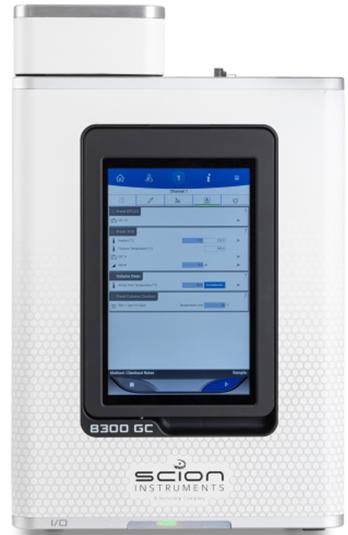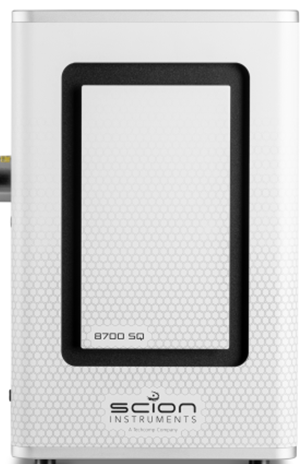Flavour and Aroma Profile of Hops Using FET-Headspace on the SCION Instruments Versa using GC-MS
INTRODUCTION
To brewers and the brewing industry, hops is an important beer component because of the flavour and aromas imparted during the hops addition process. Consequently, anticipating and/or validating the flavour profile of a particular variety of hops, based on analytical techniques, has become an increasingly useful tool in the head brewer’s repertoire.
Hops flavours and aromas are caused by many different classes of compounds including those known as terpenes. In this application note, the flavour profile of five types of hops will be identified using Full Evaporation Technique (FET) Headspace on a SCION Instruments Versa Automated Headspace vial sampler connected to a GC/MS (Gas Chromatograph/Mass Spectrometer) for chromatographic separation and detection.
Figure 1. SCION VERSA Headspace Sampler together with the SCION Instruments 8300 GC platform in combination with to 8700 SQ-MS.
Hops have become a signature flavour component of American craft beer styles beginning with use of the Cascade variety, the first American-bred aroma hops. With over 125 different types of hops varieties throughout the world, the options for hops-based flavours are broad and continually evolving. The addition of hops to the brewing process affects the resulting beer in three distinct ways, adding bitterness, flavour (Citrus, Floral, Pine Resin) and aroma during the dry hopping process. The ability to quantify the flavour and aroma components of each hops variety can greatly assist in product development as well as ongoing quality control.
This application note will focus on the flavour profile of five different types of hops by identifying the terpenes contained in their essential oils. A list of terpenes is shown in Table 1, with the most prevalent being: Myrcene, Humulene, and Caryophyllene.
Table 1. Compound name and associated nose aroma

A SCION Instruments Versa Automated Static Headspace vial sampler will be used to develop a Full Evaporation Technique (FET) for the profiling of the terpene compounds present in the hops samples. By using static headspace, only the volatile component will be transferred to the GC, leaving the non-volatile components that can foul the GC injection liner, in the headspace vial.
EXPERIMENTAL INSTRUMENT CONDITIONS
For this study, the Versa was coupled with a GC/MS system. Helium was used as the GC carrier gas, as well as the Versa pressurization gas.
The Method Optimization Mode (M.O.M.) feature of the Versa’s TekLink software was used during method development to determine optimal instrument parameters for the analysis. The GC was equipped with a SCION-5MS column. The GC,MS and headspace parameters are shown in Table 2.
Table 2. Instrumentation operating conditions.
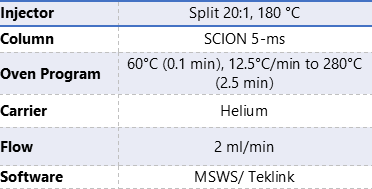
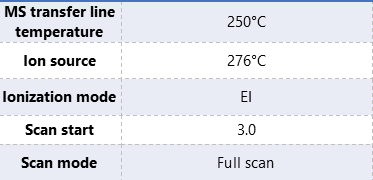
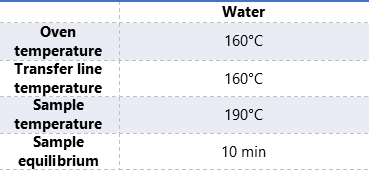
SAMPLE PREPARATION
Whole cone hops from five varieties (Cascade, Centennial, Nugget, Mosaic and CTZ) were purchased from a local home brewing store. These hops were ground into a fine powder using a knife mill. The samples were then frozen until the time of analysis. 10.0 mg of each variety was added to a headspace vial for the FET analysis.
RESULTS
M.O.M Optimization
Prior to sample analysis, two studies were run using the M.O.M. feature of the Versa’s TekLink™ software. The first study was to determine the optimum platen/sample temperature. The temperature study was evaluated from 40-190°C in 10° increments, after which it was determined that 190°C was the best choice (Figure 2).
 Figure 2. Temperature Study 40-190°C
Figure 2. Temperature Study 40-190°C
A second study was conducted to determine the optimum sample equilibration time. The sample equilibration time was varied from 5-35 minutes, after which it was determined that 10 minutes was the best choice (Figure 3).
 Figure 3. Sample Equilibration 5-35 Minutes
Figure 3. Sample Equilibration 5-35 Minutes
Flavouring Profile Study
Once the optimal method was determined, the hops samples in sealed vials were loaded in the Versa carousel and analyzed. Total Ion Chromatograms (TIC) were used to give a qualitative representation of terpenes in five different hops samples. Figure 4 shows the TIC overlay of all five hops samples.
 Figure 4. Total Ion Chromatogram of Five Hops Samples
Figure 4. Total Ion Chromatogram of Five Hops Samples
It was determined from the TIC that the major compounds identified in the hops samples were Myrcene, Caryophyllene and Humulene, all of which are key to defining the flavour and aroma of the resulting beer. Myrcene is known to provide herbal and resinous aroma, while Humulene provides woody and piney aroma. Looking closer at an Extracted Ion Chromatogram (EIC), the CTZ hops can be seen to have a Myrcene concentration much higher than other varieties (Figure 5). This also can be seen for Caryophyllene and Humulene (Figure 6).
 Figure 5. Zoomed in EIC of Myrcene
Figure 5. Zoomed in EIC of Myrcene
 Figure 6. Zoomed in EIC for Caryophyllene and Humulene
Figure 6. Zoomed in EIC for Caryophyllene and Humulene
CONCLUSION
The SCION Instruments Versa Automated Static Headspace vial sampler coupled with GC/MS successfully used a Full Evaporation Technique (FET) to quantify terpene compounds in hops samples. By using static headspace, the GC injection liner was protected from non-volatile sample components. Sample quantity was small, using the FET (10.0 mg) and sample preparation was minimal. This configuration provided a simple and effective flavour profiling solution for hop analysis.
ORDER INFORMATION

Download the Application Note
Download our full Application Note: Flavour and aroma profile of hops using fet-headspace on the SCION Instruments versa using GCMS
Keep in Touch
If you wish to keep up to date with SCION Instruments latest research and articles, follow us on social media and sign up to our newsletter below.


